Amigos de Insects Of The World Hoy les compartiré tres especies de Insectos que han llegado a mi apartamento sin pedir permiso. Uno es el Chinche o la Vinchuca, el Saltamontes Longicornios y la famosa Mantis Religiosa. Espero que este gran trío de insectos cubra las expectativas de vuestra hermosa comunidad.
Friends of Insects Of The World Today I will share with you three species of Insects that have arrived in my apartment, without asking permission. One is the Bed Bug or Vinchuca, the Longicorn Grasshopper and the famous Praying Mantis. I hope this great trio of insects will meet the expectations of your beautiful community.
El Chinche o Vinchuca, es el insecto transmisor por excelencia del llamado "Mal de Chagas". Infección causada por un parásito que se transmite al humano, por la picadura y materia fecal infectada de la vinchuca o chinche, la cual se alimenta de sangre. El Mal de Chagas, es frecuente sobre todo en América Latina. Para identificar a la Vinchuca, Tiene la cabeza alargada, patas delgadas, alargada y base de color amarillo. gran parte del torso, está cubierto por alas y manchas transversales claras. Su hábitat son las grietas , en paredes , casas y tejados. Gallineros corrales , cajas , ropa,entre otras. Se ocultan durante el día y salen a deambular por la noche. La enfermedad se podría decir que es del tipo silenciosa, pues no presenta síntomatología notoria. Afecta al corazón o el sistema digestivo de las personas infectadas, produciendo invalidez y hasta la muerte. The bedbug is the insect that transmits the so-called "Chagas disease". Infection caused by a parasite that is transmitted to humans through the bite and infected fecal matter of the bedbug, which feeds on blood. Chagas disease is common especially in Latin America. To prevent the spread we must: Este Hermoso saltamontes tipo hoja,apareció camuflado en una de mis matas una mañana. Me llamó la atención porque cuando regaba la matica, la hoja se movió y no se parecía en nada a la sembrada . Esa fue la manera como lo descubrí. A continuación, paso a explicar sus características tomadas de algunas fuentes bibliográficas que colocaré al final del post. This beautiful leafhopper appeared camouflaged in one of my bushes one morning. It caught my attention because when I was watering the corn, the leaf moved and did not look anything like the one that was planted. That was the way I discovered it. Next, I will explain its characteristics taken from some bibliographic sources that I will place at the end of the post. Insecto Nombre científico: Tettigoniidae Clasificación superior: Tettigonioidea Categoría: Familia Familia: Tettigoniidae; Krauss, 1902 Filo: Arthropoda Orden: Orthoptera Clasificación inferior Insect Muchos se mantienen ocultos en el día y muy quietos para no ser percibidos por sus depredadores, y en la noche se activan. Son herviboros polífagos en su mayoría. Dependen de la vegetación que los circunda. Many remain hidden during the day and very quiet so as not to be perceived by their predators, and at night they become active. They are mostly polyphagous herbivores. They depend on the surrounding vegetation. Esta Mantis, entró de visita a mi apartamento, y aproveché de hacerle una mini sesión de fotos. En una de las fotos está a punto de esconderse detrás de uno de los cuadros en mi sala. Las mántidas tienen visión estereoscópica proporcionada por los grandes ojos compuestos. Tienen un punto de enfoque central ubicado dentro del ojo que les permite producir una visión de alta resolución para ayudarlos a ver a sus presas. Tienen grandes cabezas triangulares con dos enormes ojos compuestos abultados. Además, tienen tres ojos simples más pequeños ubicados entre los ojos compuestos. Tienen cuellos muy flexibles que permiten que la cabeza gire y gire en casi cualquier ángulo, y dos antenas largas en la parte superior de la cabeza. Ellas poseen una pupila, que parece moverse cuando la mántis mueve la cabeza. Tiene un ojo compuesto por hasta mil diminutos ojos , eso es lo que podría tener una pupila. También tienen patas delanteras grandes con antebrazos que se pliegan, por lo que parecen estar rezando, de ahí su nombre común. Estas piernas especializadas se llaman piernas raptoriales. El nombre raptorial significa "adaptado para capturar presas". Y eso es exactamente lo que hacen con ellas. Son las grandes patas delanteras las que capturan y retienen a sus presas. Esta característica por sí sola distingue a este animal de todos los demás. Los mántidos son cazadores de emboscadas. Se posan en la vegetación durante horas y utilizan sus enormes ojos para detectar cualquier presa que se acerque. Usando sus patas delanteras enrolladas, rápidamente agarran a la desventurada presa. También tienen una serie de púas de gran tamaño que sobresalen de las extremidades anteriores y ayudan a sujetar a la presa. Otra característica sorprendente de esta criatura genial es lo que comen. Las pequeñas mantis comen principalmente otros pequeños insectos. Sin embargo, las mantis más grandes son bien conocidas por comer cosas tan grandes como ranas, lagartos e incluso aves como colibríes. Ellas acecharán a sus presas, pues son carnívoras y devoran otros insectos . Para ello, se colocan en posición erguida con las piernas abiertas y sus alñas desplegadas, para amenazar. Al caminar lo hacen con un balanceo . This Mantis, came to visit my apartment, and I took the opportunity to do a mini photo session with him. In one of the photos he is about to hide behind one of the pictures in my living room. Mantidae MantidaeChinche o Vinchuca
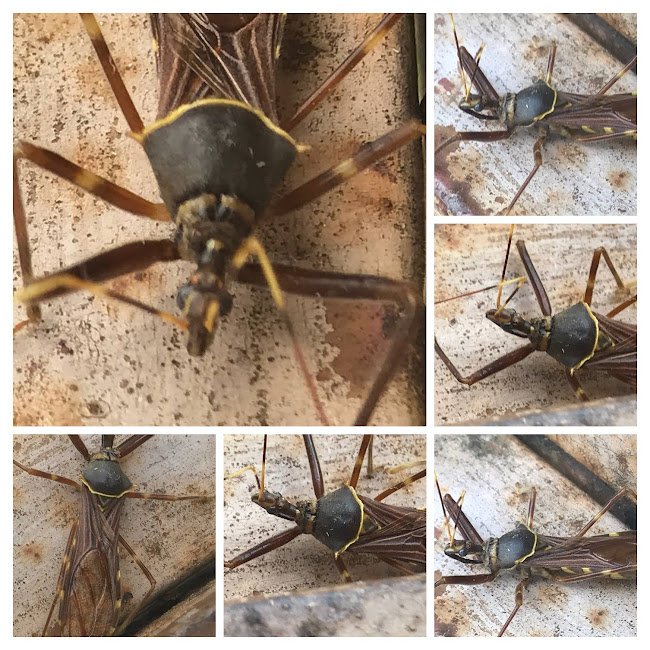
To identify the vinchuca, it has an elongated head, thin legs, elongated and yellow base. Much of the torso is covered by wings and light transverse spots.
Its habitat is the cracks, in walls, houses and roofs. Chicken coops, corrals, boxes, clothes, among others. They hide during the day and come out to roam at night.
The disease could be said to be of the silent type, since it does not present noticeable symptoms. It affects the heart or the digestive system of infected people, causing disability and even death.
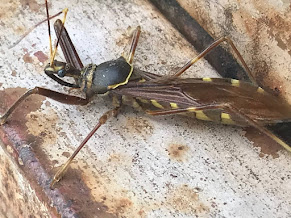

Para prevenir la propagación debemos:
de Chagas.

Saltamontes Longicornios
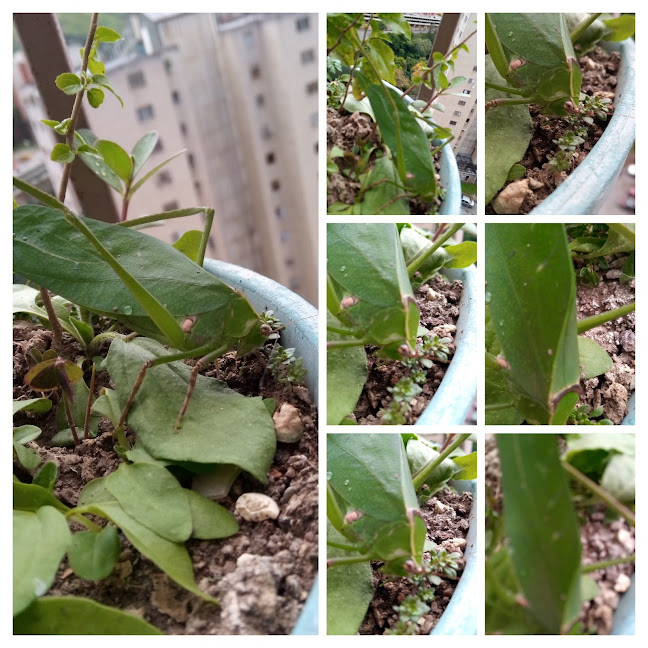
Los saltamontes longicornios, saltamontes hoja o esperanzas son una familia de ortópteros. Hay más de 6400 especies. En general son de colores crípticos, semejan hojas. Varían en tamaño entre 5 y 130 mm.
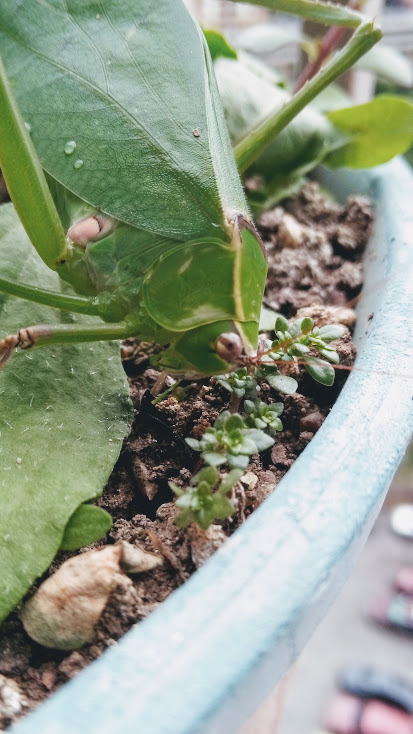

Longhorn grasshoppers, leafhoppers or hopehoppers are a family of Orthoptera. There are more than 6400 species. They are generally cryptically colored, resembling leaves. They vary in size from 5 to 130 mm.
Scientific name: Tettigoniidae
Higher classification: Tettigonioidea
Category: Family
Family: Tettigoniidae; Krauss, 1902
Phylum: Arthropoda
Order: Orthoptera
Lower classification
Fuente
Las hembras de algunas especies, como Steirodon dentatum, pueden sobrepasar los 12 cm de longitud. Los machos producen sonidos particulares cuando está en busca de la hembra. y cuando ella escucha ese sonido, le envía otro como respuesta.
Ellos también son parte importante en la dieta de otros animales.
The females of some species, such as Steirodon dentatum, can exceed 12 cm in length. Males produce particular sounds when searching for the female, and when she hears that sound, she sends him another one in response.
They are also an important part of the diet of other animals.Mantis Religiosa
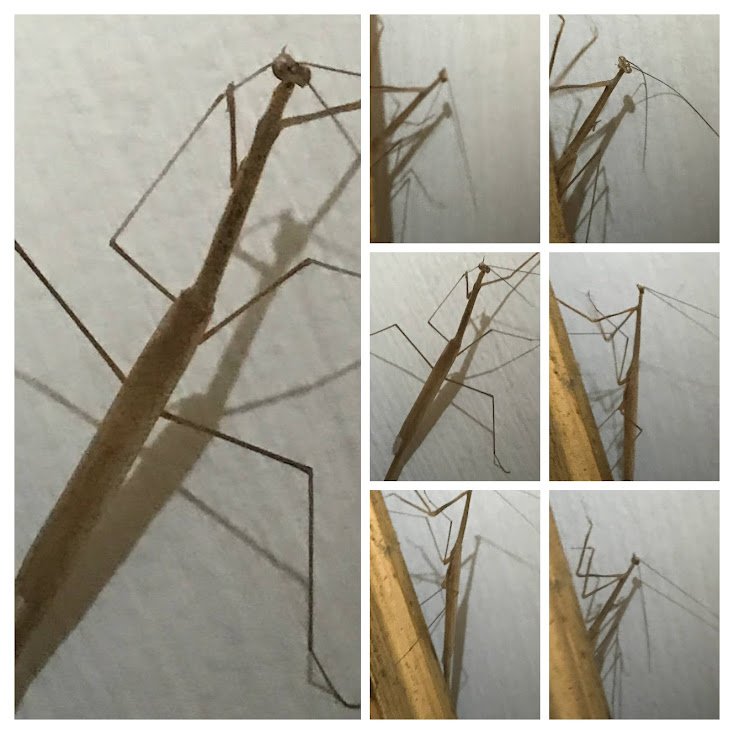
Hay algo curioso en mi Mantis, porque según veo, todas son de dos grandes ojos y un pequeño pico. La que yo encontré tiene tres ojos en línea. Al parecer es una joven. Me tome la libertad de recortar la foto y acercar más su cabeza, para que la puedan observar bien.
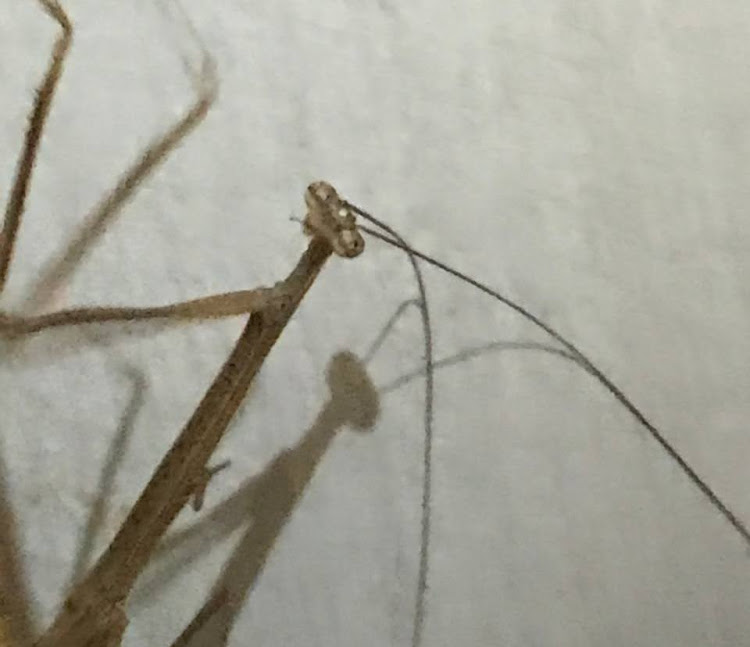

There is something curious about my Mantis, because as far as I can see, they all have two big eyes and a small beak. The one I found has three eyes in a row. It appears to be a juvenile. I took the liberty of cropping the photo and zooming in on her head, so you can get a good look at her.
Mantids have stereoscopic vision provided by large compound eyes. They have a central focusing point located inside the eye that allows them to produce high resolution vision to help them see their prey.
They have large triangular heads with two huge bulging compound eyes. In addition, they have three smaller simple eyes located between the compound eyes. They have very flexible necks that allow the head to twist and turn at almost any angle, and two long antennae on the top of the head.
They possess a pupil, which appears to move when the mantis moves its head.
It has an eye composed of up to a thousand tiny eyes, that is what a pupil might have.
They also have large forelegs with folding forearms, so they appear to be praying, hence their common name. These specialized legs are called raptorial legs. The name raptorial means "adapted to capture prey." And that is exactly what they do with them.
It is the large front legs that capture and hold their prey. This feature alone distinguishes this animal from all others. Mantids are ambush hunters. They perch in vegetation for hours and use their huge eyes to detect any approaching prey. Using their coiled forelegs, they quickly grab the hapless prey. They also have a series of oversized barbs that protrude from their forelimbs and help grip the prey.
Another amazing feature of this cool creature is what they eat. Small mantids mainly eat other small insects. However, larger mantids are well known for eating such large things as frogs, lizards and even birds like hummingbirds. They will stalk their prey, as they are carnivorous and devour other insects. To do this, they stand in an upright position with their legs open and their wings spread, to threaten. They walk with a swaying motion.
Los mántidos son una gran familia de insectos del orden Mantodea, se trata de la familia más numerosa de mantis. Pertenece a la superfamilia Mantoidea, que comparte con Hymenopodidae y Empusidae. Son principalmente de regiones tropicales y subtropicales. Wikipedia
Nombre científico: Mantidae
Clasificación superior: Mantodeos
Familia: Mantidae; Burmeister, 1838
Categoría: Familia
Reino: Animalia
Clase: Insecta
Mantids are a large family of insects of the order Mantodea, the largest family of mantids. They belong to the superfamily Mantoidea, which they share with Hymenopodidae and Empusidae. They are mainly from tropical and subtropical regions.
Scientific name: Mantidae
Higher classification: Mantodeans
Family: Mantidae; Burmeister, 1838
Category: Family
Kingdom: Animalia
Class: Insecta 
¡Que interesante colección de fotos y de información, @numa26! Está muy completo todos los datos que nos ofreces aquí. Parece mentira que ese insecto tan curioso, como es la vinchuca o chipo, sea el vector de un patógeno tan dañino, como es el causal del Mal de Chagas. Muy buen post. Saludos.
Gracias amiga @sirenahippie . Realmente cuando le tomé las fotos, no tenía conocimiento cierto de que se trataba de ese insecto, porque tal vez no lo hubiese ni siquiera fotografiado. Cuando me puse a investigarlo, hasta escalosfríos sentí. Gracias por tu gran comentario y cariños.😍
Sí, no es para menos el sentir escalofríos; por eso siempre siempre es necesario desinfectar toda fruta o verdura que vayamos a consumir, puesto que esos u otros animalitos han podido andar por allí merodeando. Que tengas feliz semana.
Buenas tomas, a mi me gustaron mas las fotografías de la mantis, me parece un insecto muy interesante y llamativo. Gracias por compartir con la comunidad.
Muchísimas gracias por tu significativo comentario. Para mi es un honor poder compartir mis hallazgos con ustedes. Saludos.
We appreciate your work and your post has been manually curated on behalf of Insects Of The World Community. It will be added to the weekly curation report. Keep up the good work.
Me siento muy honrada al conocer vuestra selección. Gracias a ustedes por su excelente trabajo, con los insectos.
I am very honired to learn of your selection. Thank you for the excellent work you do on behalf of insects.